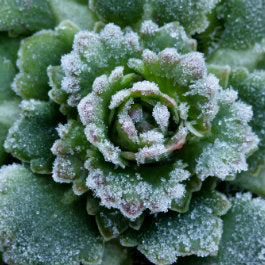
Though often thought of as the sunshine capital of the world, Australia does, in fact, get cold, and as many cool-climate gardeners will know, frost can have a damaging effect on the yard. A cold, clear night poses the biggest risk, however, not all of Australia is in danger of the big freeze; these extreme cool temperatures are generally experienced in the southern half of the country. Tasmania, ACT, some of Victoria and much of New South Wales, along with high-altitude regions, face the biggest chill factor at this time of year.
To help fight the thaw this winter we’ve put together a guide to caring for your frosty garden and how to help your plants survive through the cold snap.
Sow frost-resistant plants

Learning to cope with cold, frosty winters and the damage it can do to your plants is tough, however, there are measures you can take to make life a little easier. Nowadays there’s a plant for every climate and condition, and frost is no different. Choosing plants that are hardy for the climate where you live will help to prevent problems. Frost-tolerant plants are good for surviving a couple of days of frost, whilst frost-hardy plants will be able to cope with much lower temperatures, usually down to -10°C, for a longer period of time. Some of the plants you can sow include:
Frost-tolerant plants
· Azalea
· Banksia
· Buddleia Black Knight
· Callistemon
· Camellia
· Cordyline
Frost-hardy plants
· Agapanthus Purple Cloud
· Hydrangea White
· Juniper
· Liriope
· Rosemary
· Spiraea
Position your plants carefully

Believe it or not, your garden will likely have a series of frost-resistant microclimates that are ideal for positioning vulnerable plants during winter. Where sunlight can reach, areas that are dense in rocks and heavily sheltered spots will all impact what can grow and where. Understanding your garden’s frost-resistant pockets will help you to choose what to plant accordingly. You can even move container-grown plants to these parts of the garden when temperatures drop, for extra protection.
Protect your plants

If you’re expecting a frosty winter then wrapping up your garden to protect tender or vulnerable plants is essential. Covering these plants overnight with old sheets, horticultural fleece, cloches or tarpaulins will protect them, ideally draped over a frame to protect the foliage on larger plants, just ensure you uncover them each morning so the plants can get some sunlight. You can also secure bubble wrap around plant pots for extra insulation.
Mulching over the soil to help insulate it during cold spells will also be beneficial, though this should ideally be done in autumn to prevent the cold from getting trapped in the soil, which will stunt the growth of your plants. In very frost-prone areas it’s a good idea to rake back mulch during the day, particularly in the veggie patch, so the sun can warm the soil, then re-cover at night to keep the warmth in. Alternatively, you can lightly water plants before a frosty night to help keep the ground slightly warmer, as moist soil holds heat much better than dry.
Beware of frost damage

Frost damage can occur when plant tissue is frozen, causing its cells to shrink and allowing water to fill the space in between the cells, where it can freeze. If the water does not thaw quickly enough it can deprive the cells of water, causing them to become dehydrated. This is known as frost burn and will appear as a brown patch on your plant. Cells can also burst when water fills them and freezes, expanding the cells too much. Late winter and early spring can be a particularly vulnerable time for your plants, as this is when new foliage is forming.
Avoid pruning
It’s advisable to leave pruning until after the risk of frost has passed, as encouraging new growth can make your plants particularly susceptible to frost damage.
Treat damage…
…But only after the risk of frost has passed. Damaged growth can be pruned away from trees, shrubs and other plants. Applying a general-use fertiliser afterwards will help encourage stronger re-growth. You should also keep a close eye on any blackened foliage, as this does not mean a plant is dead. Give plants time to recover before making any decisions. Likewise, a plant can sometimes appear healthy, but once any ice crystals around its cells have thawed, it can then begin to wilt.










